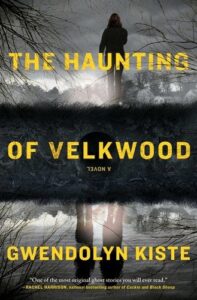A town of seemingly perfect housewives.
A severed ear in a patch of green grass.
The last man alive hiding from his monstrous neighbors.
A family ostracized from the community after their sugar bowl is poisoned.
From Ira Levin’s The Stepford Wives and David Lynch’s Blue Velvet to Richard Matheson’s I Am Legend and most of Shirley Jackson’s body of work, there’s something about the suburban gothic that keeps us coming back for more. It’s creepy, it’s familiar, and it’s omnipresent.
A broad and rather elusive subcategory, the suburban gothic focuses on the existential horror that lurks in small towns, close-knit communities, and suburban neighborhoods. These locales might not have been the original source of gothic terror, but in our modern landscape, they’ve become some of the most recognizable places in our lives—and even the most ominous.
#
When I was writing the first draft of what would become my novel, The Haunting of Velkwood, the concept of suburbia was front and center in my mind. In fact, I literally used the photography book, Suburbia, by Bill Owens as part of my mood board for the novel. (Suburbia, it should be noted, also served as the inspiration for the Detroit suburb in Sofia Coppola’s The Virgin Suicides, the candy-coated neighborhood in Tim Burton’s Edward Scissorhands, and the 1970s costume aesthetic in Close Encounters of the Third Kind. If there has ever been some kind of arcane magic in a book of photographs, then Suburbia has most definitely got it.)
So what is it about Bill Owens’ photography and the seemingly ordinary neighborhoods and families in his work that have captured so many storytellers’ imaginations?
Part of the answer lies in the way the gothic has always focused on a sense of place. It has a long tradition of depicting its physical locations as almost mystical and sentient. After all, what would Wuthering Heights be without the brooding moors, or Jane Eyre without Thornfield and all the secrets locked away in the attic? Dracula thrives off the terror of Carfax Abbey and Castle Dracula, and it’s virtually impossible to remember The Picture of Dorian Gray without his mansion and its hidden room and hidden portrait. These locales are filled with just as much nuance and complexity as the characters that dwell within them. They’re strange and dark and haunted, untold dangers lurking at every turn.
But while traditional gothic settings tend to include ancestral estates and vast, foreboding landscapes exposed to the ravages of nature, the neighborhoods of the suburban gothic don’t seem nearly as threatening. They’re so new, so brightly lit, as to appear perfectly normal. Sprinklers in well-manicured lawns, ice cream trucks on summertime corners, allotments arranged in neat rows with identical houses peering back at you. Whether in daylight or moonlight, it feels like we should be safe here.
And that’s exactly where the horror thrives.
David Lynch knows all too well the terror of suburbia and small towns. The opening of Blue Velvet literally digs deep into the mythos of suburban life, exposing the unseemly underbelly waiting there. Early on in the film, the camera focuses on a bright blue sky and a literal white picket fence with beautiful red roses growing in front of it. From there, we see respectable houses and a line of schoolchildren placidly crossing the street. But nothing is as it seems. A man watering his grass is suddenly stricken and collapses without anyone else noticing, his body left shaking on the ground. That’s when the camera descends into the earth, the dirt rising up around us like we’re a corpse, as we see the darkness and the rot and the hungry insects lurking beneath us all the time. Before long, our protagonist will inadvertently come across the single object that sets the whole film into motion: a severed ear. Blue Velvet might begin with a sunny day in suburbia, but it knows where this all ends: in devastating secrets and unspeakable violence. We want to believe terrible things only happen if you find yourself in a dim alley among nefarious strangers, but the truth is if you have something to fear in life, it’s almost certainly going to happen in a place you recognize among people you know well.
This ubiquitous danger of suburbia has permeated other famous media of the last half century. The town of Stepford appears to be a wonderful place to raise your kids; that is, until you realize all the women are strangely glassy-eyed and robotic, thanks to the cruel appetites of their narcissistic husbands. The Lisbon family in The Virgin Suicides are an apparently idyllic family—and then the bereft daughters begin to kill themselves while the befuddled neighborhood watches, unable or unwilling to do anything to stop it.
While the suburban gothic can be set anywhere, it’s sometimes seen as a subsection of the American gothic, and maybe there’s a good reason for that. The so-called American Dream promises us a life of comfort and stability and bright-eyed happiness (so long as you commit to a life of drudgery to a corporate overlord). But as the suburban gothic so adeptly explores, any alleged promises are only an illusion. No matter where you go, the terror is sure to follow.
#
Gothic literature has long been a reflection of our collective fears, and the stories have evolved over the decades to convey that. With the suburban gothic, it asks a fundamental question that haunts our modern lives: is home a haven or a hellscape? Can the friendly smiles of our neighbors keep us safe from the outside world? Or are we simply creating our own prisons?
If there was ever a writer who didn’t trust her small-town neighbors, it was no doubt Shirley Jackson. Look no further than her classic short story, “The Lottery,” if you want to see what people will do to maintain their beloved traditions. Jackson understood better than most that the places that should keep us safe often become the most unsettling and dangerous settings in our lives.
While The Haunting of Hill House is often described as Jackson’s crowning achievement, her final novel, We Have Always Lived in the Castle, perhaps succeeds even better at capturing the dread of insular communities. After most of the Blackwood family is poisoned, sisters Constance and Merricat live an isolated existence away from the townspeople who despise them. The locals assume Constance is a murder, though most readers will quickly deduce that younger sister Merricat is clearly the culprit. Although the book never explicitly explores the reasons for Merricat’s hatred of her family, there are intimations of her father’s abusive nature as well as mysterious arguments that hint at deeper secrets that are never revealed to the reader. Whatever the motive, in Merricat’s eyes, there was no safety for her within or without, not in the village and not in her own family, at least until she took matters into her own bloodthirsty hands. Only then did her house become a sanctuary for her.
#
Home. It’s a simple word but such a tricky notion. It’s much easier to describe a house itself—the physical dimensions of a literal space with a roof and rooms and a mortgage to pay.
But a home is something we each learn to define through our own eyes and our own experiences. Your memories growing up might be all about comfort food and Christmas mornings and togetherness. Or maybe it was screaming matches and latch keys and loneliness. Perhaps it was all of those things or none of them at all.
The suburban gothic manages to encapsulate all those perspectives while also acknowledging that in one way or another, every house is a haunted house. And it doesn’t have to be one that’s filled with ghosts; plenty of haunted houses are occupied solely by the living.
Returning once more to the work of Shirley Jackson, her lonely protagonist Eleanor Vance in The Haunting of Hill House is a woman without a home and without a future. After dedicating her whole life to her hateful mother, there’s not much left of the hopes and dreams she once had. With Eleanor, Shirley Jackson asked a question that still gnaws at me years after I first read Hill House: what if a haunting isn’t only a place, but also a person? What if your trauma and all the pain of your past have turned you into a living, breathing haunted house? Because while you might be able to flee Hill House, there’s no way to escape yourself.
And as the suburban gothic proves, perhaps we’re the most frightening phantoms of all.
***


















